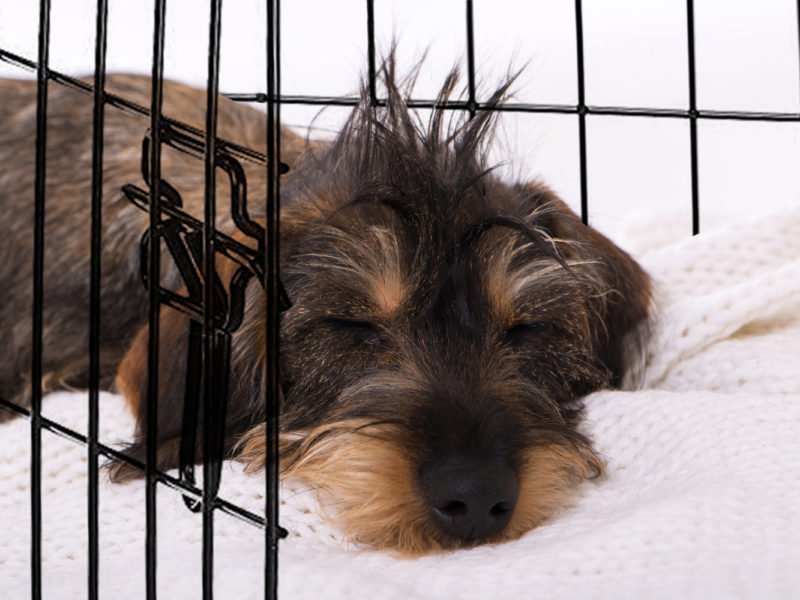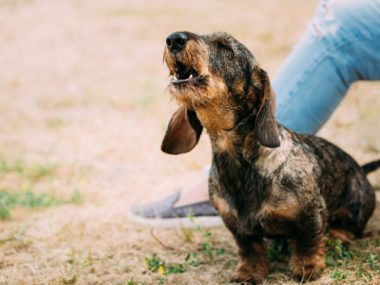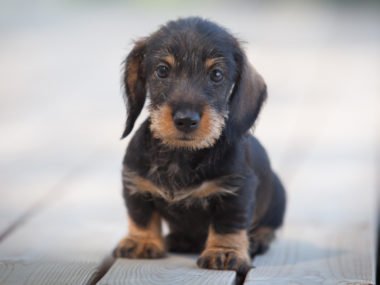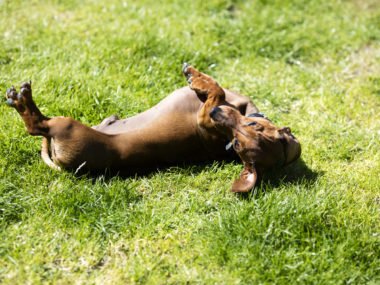Have you just got a new dachshund puppy? Are you wondering if crate training is a good idea? Or have you bought a crate but don’t know where to start? If you have any questions on how to crate train your dachshund puppy, this article has been written for you!
How do you crate train a dachshund puppy?
- Buy the right size crate
- Put the crate in your bedroom
- Add a soft cushion base
- Drape a blanket over the top and three sides
- Add something that smells of you
- Remove your dachshund’s collar
- Encourage your dachshund inside with treats
- Shut the door for short times and build slowly
- Don’t put food or water in the crate overnight
- Make sure your puppy wees before bed
- Use soothing words to settle your puppy a night
- Don’t crate your dachshund for too long
Read on to find out why to use a dog crate, what size crate to buy, how to set it up, what to put inside, how to introduce your puppy to the crate, what to do if he cries and what to expect for the first few nights.
Table of Contents
- Why use a crate for your dachshund puppy?
- Should you buy a wire or plastic dog crate for a dachshund puppy?
- What is the best crate size for a dachshund puppy?
- How do you set up a crate for a dachshund puppy?
- Where do you set up a crate for a dachshund puppy?
- Should I put food in the crate with my dachshund puppy?
- Should I put water in the crate with my dachshund puppy?
- Should you put dog toys in a dachshund’s crate?
- Do you remove a dachshund’s collar when in the crate?
- How do you introduce a dachshund puppy to a crate
- How do you use a crate in the day?
- How do you use a crate in the evening?
- What should you expect for the first few nights of crate training?
- What do you do if your dachshund puppy cries in the crate?
- What do you do if your dachshund puppy pees in the crate?
- How long can you leave a dachshund in a crate?
- Is crate training a dachshund cruel?
- Is it hard to crate train a dachshund puppy?
- Can you crate train an older dachshund?
- How much is a dog crate for a dachshund?
- How long does it take to crate train a dachshund puppy?
- What is the next step?
- What do I do next?
This article is based on research and personal experience as a Dachshund owner of 10+ years. I’m not a Vet or qualified dog behaviourist.
Why use a crate for your dachshund puppy?
Crates are excellent for potty training and make things so much easier. The reason they work so well is because a dog’s natural instinct is to keep their den clean. Basically, dachshunds don’t like to wee or poo where they eat and sleep!
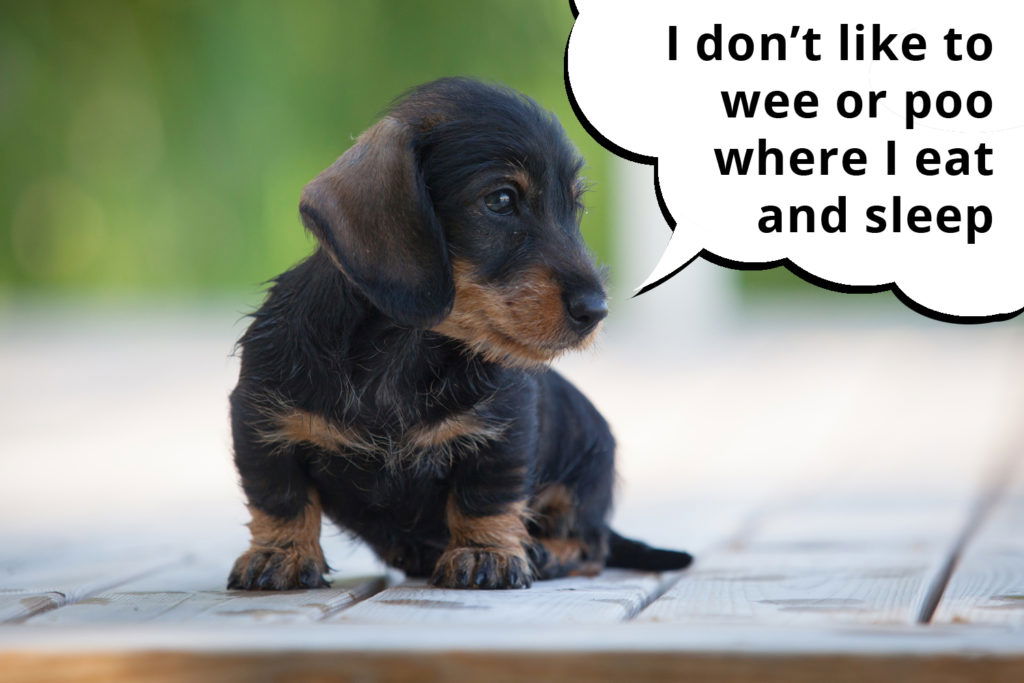
Crates keep your dachshund safe and secure
Crates keep your dachshund safe overnight and when you’re not in the room. So, if you have to nip to the loo or answer the door, you know your pup is safely contained. If you leave him to wander freely around your home, he COULD chew through wires or nibble the edges off your kitchen cupboards. Dachshunds can get up to all sorts of mischief if left to their own devices!
You could also use a playpen or baby gate to contain your dachshund to one area of your home, but this won’t work for potty training. The space would be too big for your dachshund’s natural ‘clean den’ instinct to kick in. Basically, he’d pee down one end and play down the other!
A contained area is still a good thing to have, but you’ll need to watch your pup like a hawk for signs he needs to go! For night-times or when you leave the room, it’s best to pop him in the crate.
Crates are practical when you go away
Crates are useful for travel too. If you go away and can take the crate with you, it’ll be a familiar space for your dachshund to sleep in. He’ll feel much more settled because, let’s face it, there’s nothing better than sleeping in your own bed!
Crates are handy for vet trips and emergencies
Crates are very handy for vet trips. Sadly, 1 in 4 dachshunds are prone to Intervertebral Disc Disease (IVDD) and, depending on the severity of the episode, the first stage of treatment is crate rest. If you crate trained your dachshund as a pup, it’ll hopefully make the whole situation much less stressful and traumatic.
Also, if your dachshund has to stay in one of the vet’s crates for any reason, he’ll feel more comfortable if he’s crate trained and used to it. That’s not to say other dachshunds wont cope, it just makes things a bit easier.
Crates are good for downtime
If you have kids running around, a crate is a great place for your puppy to have some downtime. You may even want a house rule that, if the puppy is sleeping in the crate, he must be left alone to rest. A young pup needs a lot of sleep and mustn’t be over-exercised or played with excessively. So a crate is a great place for him to recharge for a few hours!
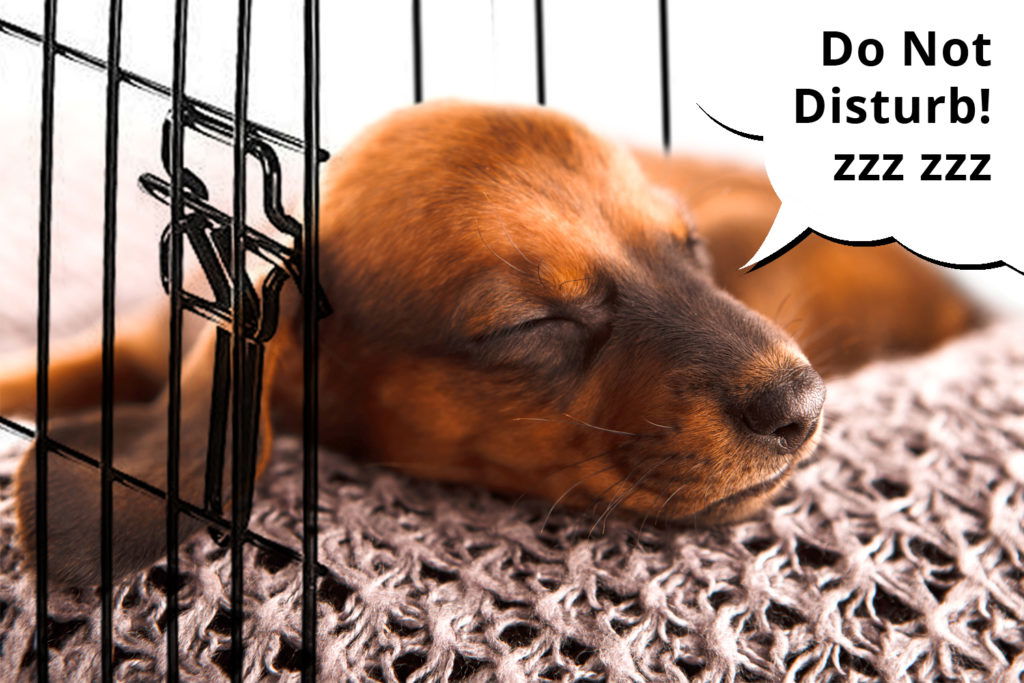
Crates are cosy dens
Some dachshunds are prone to anxiety and can get a bit stressed when there’s unfamiliar people around. So, if you have people over and it gets a bit noisy, your dachshund may choose to chill out and relax in his crate. It’s the ideal place to escape to if things get a bit too much.
Crates promote independence
Dachshunds are a very loyal breed that bond intensely with their owners. Some dachshunds can get a bit too attached, and this can cause problems when you need to leave the house. A crate teaches your dachshund how to be independent. It’ll provide him with a safe, quiet, calm bedroom he can call his own. It’ll show him he doesn’t need to be glued to your side to be happy and content. Dachshunds that are crate trained tend to suffer less from separation anxiety.
In general, crates are both helpful and practical. Once your puppy is a bit older and potty trained, you can relax all the rules. There’s no need to crate an adult dachshund unless it’s for health or other specific reasons. But, having said that, a lot of dachshunds choose to curl up and snooze in their crate, so just leave the door open and let him do what he wants. Once trained, most dachshunds should be fine around the home.
Should you buy a wire or plastic dog crate for a dachshund puppy?
A wire crate is more practical, more durable, folds down flat for storage or transport and is easy to clean. The bottom tray slips out if there are any accidents. Once covered in a blanket or fitted fabric cover, it looks like a cosy den. Visibility is good so your dachshund can see everything around him.
What is the best crate size for a dachshund puppy?
As a guide, the best crate size for a miniature dachshund is 24 inches and the best crate size for a standard dachshund is 30 inches. It needs to be big enough for your dachshund to get up, sit down and turn around, but not SO big that your puppy can potty down one end and sleep at the other.
Choose the crate size based on an adult dachshund
Always buy a crate based on a fully-grown dachshund. When your puppy is really small, you can always put a dog bed (one with the squishy rounded sides) inside the crate to use up more space and make it feel smaller. Some crates have dividers that can be moved along to free up more space as they grow.
Adapt the crate guide size to suit your dachshund
All dachshunds are different shapes and sizes so, if you have an above average size dachshund or a cross breed, you need to adjust the crate size guide to suit.
If your dachshund starts to outgrow the crate, you need to buy a new one. Don’t leave your dachshund in a crate that’s too small or restrictive. He must never feel trapped inside or unable to move around. You have to find the right balance.
Check the crate fits inside your car
Some people crate their dachshunds to keep them safe while travelling. So, if you plan on putting the crate in your car, check the height as well as the width and depth, so you know whether it fits. If you have a small car, you may need to buy two crates. One that fits in your car and a bigger one for use in your home.
How do you set up a crate for a dachshund puppy?
Start by making the crate really cosy. Put a soft base or cushion inside the crate with some warm blankets. Drape the sides and back of the crate with a blanket to create a snuggle-den, but leave the front open so your dachshund can see out. Alternatively, buy a fabric pet cover for your dog crate.
Obviously, if you live in a very hot climate, you may need to use lightweight sheets that are cooler, rather than thick, heavy blankets. And, to make life easier, buy things that are machine washable!

Add a familiar scent to the crate
For comfort, put something inside the crate that smells of you. An old t-shirt that’s been worn recently and not washed is good, or maybe something you got from the breeder that smells of his mum. This’ll give your puppy some reassurance during the night and help him sleep.
Just bear in mind that puppies chew! Don’t leave your dachshund unsupervised in the crate with anything that could be ripped apart and eaten. Some innocent looking items can potentially be harmful, so use common sense.
Put a dog bed inside the crate
If you have a tiny puppy and the crate is too big to start with, put a dog bed inside the crate (one with the round squishy sides) and use this as the base. As he grows, you can replace the dog bed with a soft cushion base.
Put a heart beat sheep in the crate
A ‘Heart Beat Sheep’ is a soft toy with a small device inside that produces a heart beat vibration that mimics his mum’s. The heart beat will comfort your dachshund and help him with any separation anxiety. You could also use a ticking clock as this has the same effect.
Use a puppy heat pad in the crate
A ‘puppy heat pad’ can also help your dachshund adjust to his new surroundings. You can get small pads with fleece covers that can be microwaved for up to 10 hours of heat. When your puppy sleeps with one, he feels like he’s laying next to his mum and siblings.
Keep a night light on
It’s frightening for any new puppy when they go to a new home. So, for the first few weeks, it’s best to leave a dim night light on, or a hall light, so your puppy can see you and isn’t in pitch dark.
Use a pet camera
If you can, set up a camera to check in on your dachshund when you’re not there. Being able to watch a live feed will give you the reassurance all is OK. A Furbo is a great option that allows you to chat to your dachshund remotely and also dispense a treat!
Where do you set up a crate for a dachshund puppy?
If you have space, it’s best to set up the crate in your bedroom to start with. This is just for the first few weeks to give your puppy time to settle in. In time, you can gradually move the crate further away. Being close by gives your new puppy the reassurance of knowing you’re there.
Crates can easily be moved around but, if you’re able to set up two crates, it’ll make life easier. Have one in your bedroom and one elsewhere in your home, like a kitchen or lounge. It’s better to have the ‘day crate’ in the place where you spend most time as a family. You want your pup to be able to see you and feel included at all times.
Think about the environment of the crate too. You don’t want it in direct sunlight or somewhere that gets too chilly. You want an average room temperate with nothing around it, like wires, that your dachshund could drag inside and chew.
Should I put food in the crate with my dachshund puppy?
No, don’t leave food in the crate. Dachshunds don’t tend to leave food sat around for long, so it’ll be gone in 3 seconds flat! It’s better to have set mealtimes and for someone to pop in and feed you dachshund if you’re not there. Puppies will need 3-4 meals a day and adult dachshunds 2 meals a day.

Should I put water in the crate with my dachshund puppy?
If you’re home and the crate door is open, a water bowl outside of the crate is fine. But, if your dachshund is crated for any length of time, you obviously need to make water available. It’s best to use a clip on bowl or bottle that attaches to the crate, rather than one that could easily be knocked over.
Don’t leave your dachshund crated too long
Obviously, dogs need water to drink throughout the day. So, if you don’t have water in the crate, you need to be sensible about how long your dachshund is left. Your puppy should only be crated with the door shut if you need to pop out for a short time or overnight when you can’t watch him.
Ask someone to call in
If you leave your dachshund crated for longer, you must make water available. In these situations, it may be best to ask someone to pop in and take your puppy out for a wee. The younger the puppy, the more potty breaks he’ll need!
Don’t leave water in the crate overnight
If you’re using the crate for potty training, don’t leave water in the crate overnight. If you do, your dachshund will need to wee more, as puppies can’t hold their small bladders for long!
Think about medical conditions
Some medical conditions like Diabetes, Cushings disease or even certain medications may mean your dachshund needs water available at ALL times. So just be sensible and do what’s right for your dog and situation.
Should you put dog toys in a dachshund’s crate?
Yes and no. Toys are great but they can also be destroyed. Stuffing and squeakers can be ripped out, ears and tails can be chewed off and any parts easily swallowed. If you’re supervising, it’s fine, but if you’re going out, a Kong or similar may be a better option (although nothing is indestructible!)
Dachshunds obviously need toys to play with, but you have to use your own judgement on safety, especially when leaving young pups alone.
Do you remove a dachshund’s collar when in the crate?
Yes, for safety, you should always remove your dachshund’s collar when he’s inside the crate. It could get caught up or tangled on the bars and may cause him harm. Collars are very easy to remove so it’s best not to take any chances.
How do you introduce a dachshund puppy to a crate
Spend a day letting your puppy explore the crate. Don’t shut the door right away. Lock his food inside the crate, but keep your dachshund on the OUTSIDE of the crate. That way he’ll be desperate to get inside to eat! Leave it 5 minutes before opening the door and then he’ll see the crate as a place of reward.
Make the crate a fun place
You can keep the crate door open while he’s eating, no need to shut it then. It’s about making the crate a fun place to be, a place of reward, not punishment. You can also do this with toys and treats too. Lock them inside the crate and open the door as a treat. Turn it into a game and make it fun!
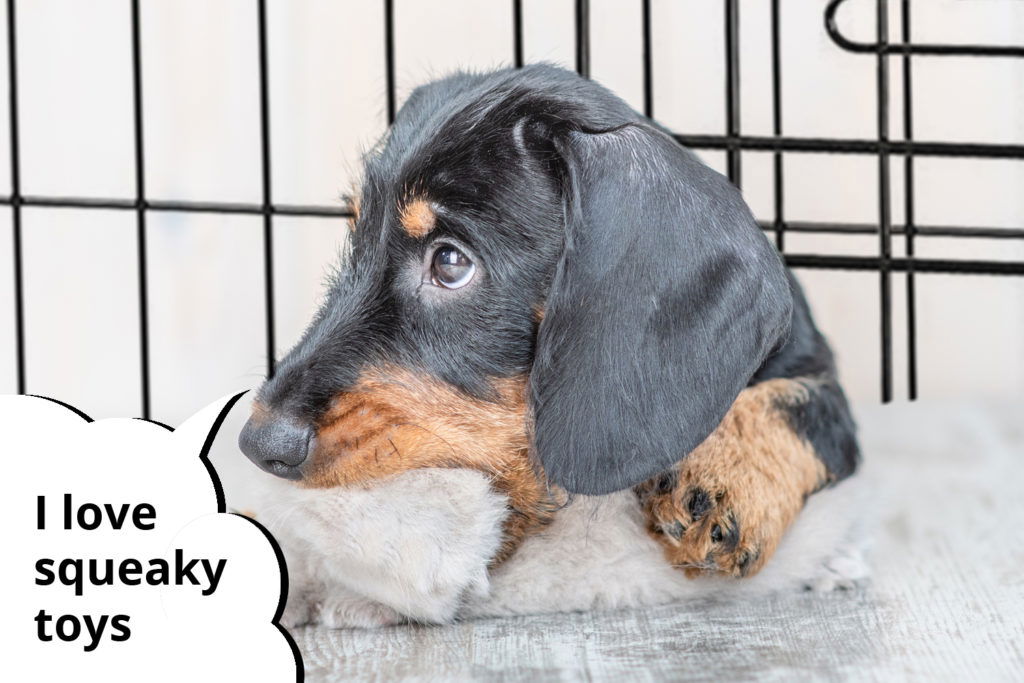
Take things slowly
If your dachshund is still unsure, put some food or treats by the entrance of the crate and then slowly move them further back. He’ll soon build confidence and venture inside. Hide treats under the blankets too so he has to sniff them out. That way he’ll get used to things more gradually.
Shut the crate door for a short time
Once you’ve got your puppy going in and out on his own, it’s time to shut the crate door. Start with 2 minutes at a time and build slowly from there. Stay in the room but act like it’s no big deal. He may cry or whine a little, but don’t stress or he’ll pick up on this. You need to stay calm and carry on like you normally do.
Praise your dachshund
In time, your dachshund should start going in and out of the crate on his own. Make sure you praise him when he does. The more he gets used to the crate and understands he’s safe, the easier the night-times will be.
How do you use a crate in the day?
You don’t have to crate your puppy in the day as long as you’re watching him and looking for signs he needs to go. The crate is only there to stop him weeing and pooing inside when you can’t watch him, and for sleeping in overnight.
So, if you’re home in the day, it’s a good idea to leave the crate door open and let your dachshund go in and out as he pleases. If he wants to have a sleep or play in there, then that’s great. The more relaxed he is around the crate, the better.
When your puppy gets tired, put him in the crate. If he falls asleep, close the door. When he wakes up, take him out for a wee. You want to get to the point where your puppy chooses to go and lay down in the crate with the door open, and isn’t bothered when it’s shut.
You can also use the crate to do some potty training. Put your dachshund in the crate and take him outside every 20 minutes. If he goes to the toilet, give him a treat and a fuss. If he doesn’t, wait 10 minutes and then take him back to the crate. Repeat the whole thing every 20 minutes until he gets the hang of it!
If you work, it’s best to take a few weeks off. Get your puppy settled and start the new routine. Organise for someone to pop in when you’re not there. It will have its challenges but, with a bit of help from friends and family, you can definitely make it work.
How do you use a crate in the evening?
When you get a new puppy, you’ll naturally want to cuddle and hold him all the time. But, this can make crate training harder! If your puppy gets used to curling up on your lap in the evening, he’s not going to like it much when you put him in the crate at night.

Cuddle times are of course the best thing ever but, while training, you should always put your puppy back down. Just pop him in his crate nearby and cover him over with a blanket. You don’t have to shut the door. You’re just trying to teach him that THIS is his bed. Then, the transition to night-time is easier, because the only difference is shutting the crate door.
This isn’t easy, but it isn’t forever. Just until your dachshund is crate and potty trained. After that, you can relax all the rules and snuggle with your dachshund on the sofa or wherever you want.
Of course, this isn’t for everyone. Some people prefer to have their dachshunds cuddled up with them all the time, and that’s OK too. It’s whatever works for each person and their dachshund. Crate training is still possible either way, but you may get a bit more resistance about going into the crate at night if he’s been asleep on your lap all evening!
What should you expect for the first few nights of crate training?
Your dachshund puppy may cry in the crate at night to start with. Just make sure he’s had enough toilet breaks and then say ‘Settle Down’ in a soft voice. Keep repeating the same words. When he’s silent say ‘Good Boy’. He may take a few days to settle but, if you stick to the routine, it will get easier.
What do you do if your dachshund puppy cries in the crate?
However hard it is, if your dachshund cries in the crate, don’t rush in and let him out straight away (unless it’s for a genuine reason of course). If you do, you’ll be teaching him to cry or bark when he wants to be let out. Wait for that ONE moment he’s quiet before opening the door and then give him a fuss.
If your dachshund cries constantly, he may need the loo. Young pups have very small bladders, so you may need to get up during the night to take him out for a wee.
What do you do if your dachshund puppy pees in the crate?
If your dachshund wees or poos in the crate, just clean it up. There’s normally a base tray which you can pull out to scrub clean. You’ll need to use a special pet cleaner to remove any trace of the scent. If you don’t, your puppy may think it’s OK to wee or poo in the same place again.
You also have to question WHY this happened:
- Is the crate too big possibly?
- Was your dachshund left alone too long?
- Is your puppy too young to hold his bladder all night?
- Did your puppy cry to go out during the night?
- Did your puppy eat or drink too late?
- Is your puppy sleeping too far away from you at night?
- Are you sure your puppy wee’d before bed?
- Is your puppy unwell?
- Was it just a simple accident?
Whatever you do, don’t shout at your dachshund for having accidents. He’s not trying to be naughty, he just couldn’t hold it for some reason. If you shout, you’ll make him wary of you – and you don’t want that!
You can only correct the behaviour (a quick ‘No’ and take him straight outside) if you catch him in the act. If you don’t, you just have to ignore it, clean up, and watch him more closely in future.
How long can you leave a dachshund in a crate?
Dachshund puppies should only be crated for a maximum of 2 hours spread throughout the day and, adult dachshunds, no more than about 4 hours. They can also be crated overnight, but very young pups may need to be taken out during the night.
If you leave your dachshund alone too long, he’ll have no choice but to go to the toilet. He just won’t be able to hold it. And, once he’s done it once, it’ll be harder to get him to stop.
Once trained, adult dachshunds shouldn’t need to be crated at all. Some may choose to sleep in their crate, but you can leave the door open so they can come and go as they please.
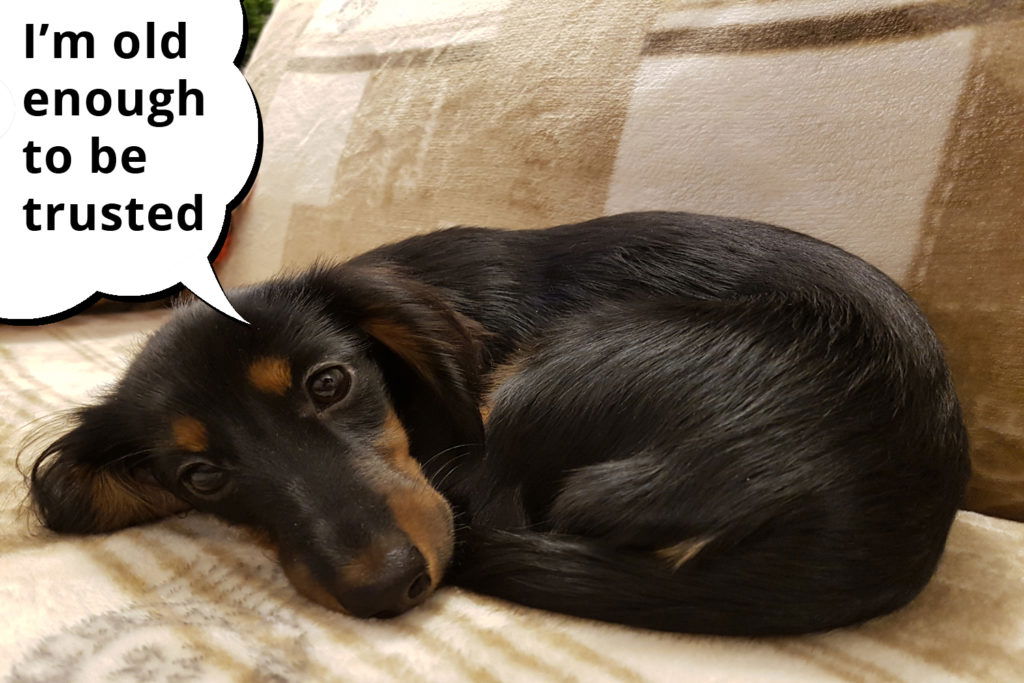
Is crate training a dachshund cruel?
No, crate training isn’t cruel, as long as it’s done responsibly and in the right way. Dachshunds are natural denning animals that like to curl up in cosy, confined, dark spaces where they feel safe and secure. So crates are the perfect snuggle-dens!
However, crating your puppy for long hours while you’re out all day isn’t OK. Neither is using the crate as ANY form of punishment. Your puppy only needs be crated with the door shut if you pop out for a short time or overnight when you can’t watch him. If you work, you need to organise for someone to call in and take him out for you.
Some people choose not to crate train, and that’s OK too. Every owner should train their puppy in the way they feel is best.
Is it hard to crate train a dachshund puppy?
No, it isn’t hard to crate train a dachshund puppy, but there is some tough love involved. Dachshunds are very loyal and attach themselves intensely to their owners, so may put up some resistance about going in the crate at first.
If you stick to the routine your dachshund will settle down but, if you give up and put him in your bed, there’s no going back from that!
Can you crate train an older dachshund?
Yes, you can crate train an older dachshund but it’ll take more time. It also depends where your dachshund used to sleep before he came to live with you. Asking a stubborn dachshund to unlearn old habits can be very hard to do! So take things slow, be patent and focus on repetition.
If he takes to it, then great, but don’t force it. Most adult dachshunds do fine without being crated and will happily sleep in a dog bed.
How much is a dog crate for a dachshund?
A 24 inch wire dog crate for a miniature dachshund costs around £20-£25 ($26-$32) and a 30 inch wire dog crate for a standard dachshund costs around £30-£35 ($39-$45). These prices may vary depending on where you live.
How long does it take to crate train a dachshund puppy?
Most puppies get used to the crate within about a week. Some take just 48 hours, and some a little longer. It just depends on the dachshund and how much work you put into training. However, crate training is different to potty training. Potty training does take longer and involves more steps.
What is the next step?
The next step is potty training! To learn how to use the crate for potty training your dachshund, click here.
What do I do next?
If you read all the way to the end of this article, you’re exactly the sort of person I’d LOVE to join my Facebook Group. Your support for my blog means everything to me so, if you found this article helpful, please kindly share below. Thank you! 💋

